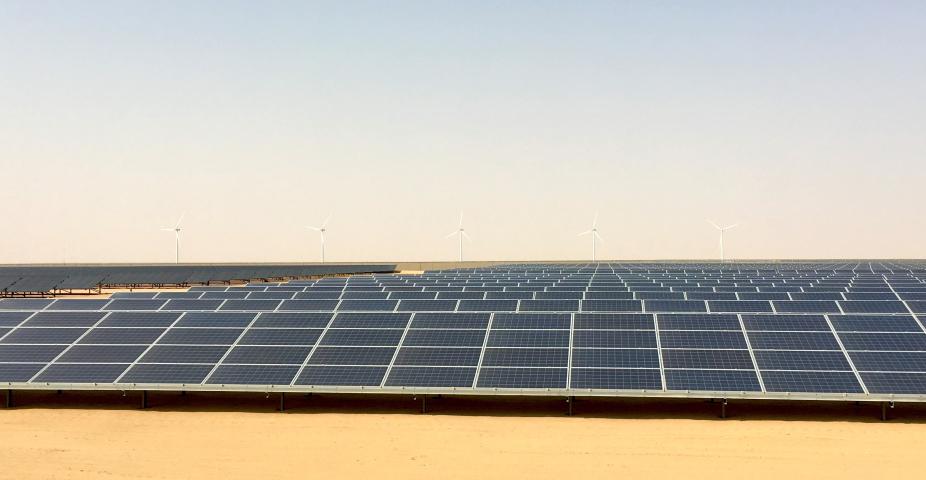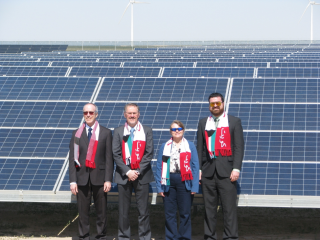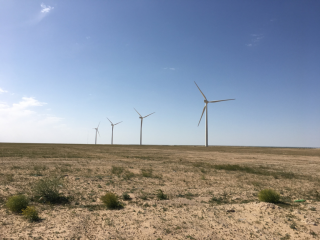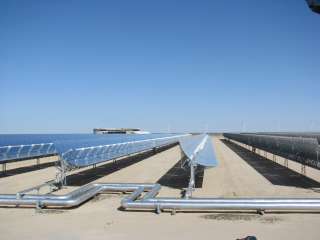Renewable Energy Forecasting for Kuwait

NCAR’s Renewable Energy Forecasting for Kuwait project, a 3-year, $5.1M project sponsored by the Kuwait Institute for Scientific Research (KISR) (https://news.ucar.edu/126802/ncar-develop-advanced-wind-and-solar-energy-forecasting-system-kuwait), began in July 2017.
The ultimate goal of this project is to deliver to KISR an operational wind and solar power forecasting system, for both nowcasting and day-ahead time horizons (and beyond), with which they can provide forecasts to their national power grid operators and wind/solar power plant operators. The forecasting system is called the Kuwait Renewable Energy Prediction System (KREPS).
Kuwait has a stated national goal of 15% renewable energy generation by 2030, and to that end has established the Shagaya Renewable Energy Park in the desert about 100 km west of Kuwait City. Phase 1 of Shagaya is now complete, with demonstration-scale 10-MW photovoltaic (PV) solar (Figure 1) and 10-MW wind plants (Figure 2) that were commissioned in May 2017, and a 50-MW concentrated solar power (CSP) plant (Figure 3) that was commissioned in December 2018. The official Grand Opening for the Shagaya Renewable Energy Park was held in February 2019.
Phase 2 of Shagaya will include a 1500-MW PV solar plant, which will be the second-largest PV plant in the world. Construction of this 1500-MW al-Dibdibah PV plant at Shagaya is hoped to begin late in 2019 or in 2020, with completion expected after the end of NCAR’s initial 3-year project. Additional wind, PV solar, and CSP solar capacity is planned beyond that in Phases 2 and 3 of Shagaya, with a goal of 3–5 GW of combined wind and solar power installed capacity at Shagaya by 2030. We hope to continue our partnership with KISR to grow and improve KREPS as more renewables come online in Kuwait.
The NCAR team, in collaboration with researchers from Penn State University and Solar Consulting Services, has been building various aspects of KREPS, leveraging advancements made on several past and current renewable energy forecasting projects in RAL, and developing new and improved techniques and products with pioneering research. Key components of the fully engineered system include high-resolution WRF-Solar® forecasts, a newly developed blend of WRF with MADCast (MAD-WRF) to improve cloud initialization for nowcasting, NCAR's DICast® system that produces dynamically blended and tuned forecast for the various sites, an analog ensemble (AnEn) implementation to quantify the uncertainty in the forecasts, and the StatCast-Solar and StatCast-Wind models that use machine learning techniques and recent real-time observations to generate nowcasts. A Display system to show operators and researchers the past and present performance of KREPS has also been developed. Assessment and development of the system and its components are ongoing, and KREPS will be transferred to KISR by the scheduled end of the project in summer 2020.
Several conference presentations and journal papers have already been submitted that stem from research accomplished on this project (click on the Resources tab to see a list of these references), and many more are planned through 2019 and 2020.
REFERENCES
Alessandrini, S., S. Sperati, and L. Delle Monache, 2019: Improving the analog ensemble wind speed forecasts for rare events. Mon. Wea. Rev., conditionally accepted and in revision.
Al-Rasheedi, M., C. A. Gueymard, A. Ismail, and T. Hussain, 2018: Comparison of two sensor technologies for solar irradiance measurement in a desert environment. Sol. Energy, 161, 194–206, https://doi.org/10.1016/j.solener.2017.12.058.
Brummet, T., J. A. Lee, and G. Wiener, 2019: The relationship between GHI and power in Kuwait. 10th Conf. on Weather, Climate, and the New Energy Economy/18th Conf. on Artificial and Computational Intelligence and its Applications to the Environmental Sciences. Phoenix, AZ, Amer. Meteor. Soc., J3.4, https://ams.confex.com/ams/2019Annual/meetingapp.cgi/Paper/350578.
Gueymard, C. A., and P. A. Jiménez, 2018: Validation of real-time solar irradiance simulations over Kuwait using WRF-Solar. 12th Int. Conf. on Solar Energy for Buildings and Industry (EuroSun 2018). Rapperswill, Switzerland, Int. Solar Energy Soc., 2.A-1, https://doi.org/10.18086/eurosun2018.09.14.
McCandless, T. C., and S. E. Haupt, 2019: The super-turbine wind power conversion paradox: Using machine learning to reduce errors caused by Jensen’s Inequality. Wind Energy Sci. Discuss., in review, https://doi.org/10.5194/wes-2018-74.
Naegele, S. M.,T.C. McCandless, S. E. Haupt, G. S. Young, and S. J. Greybush, 2019: Climatology of Wind Energy Variability for the Kuwait Region. 10th Conf. on Weather, Climate, and the New Energy Economy/18th Conf. on Artificial and Computational Intelligence and its Applications to the Environmental Sciences. Phoenix, AZ, Amer. Meteor. Soc., 10.2, https://ams.confex.com/ams/2019Annual/meetingapp.cgi/Paper/352390.


